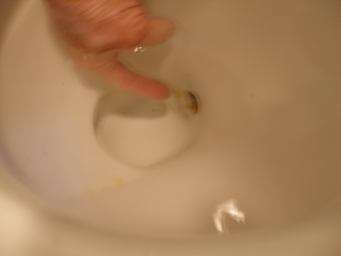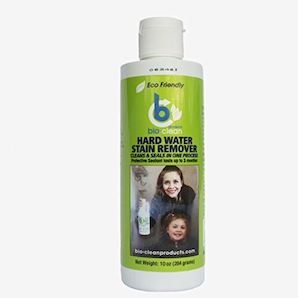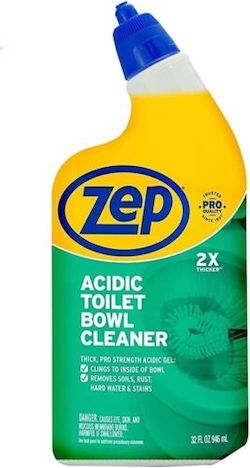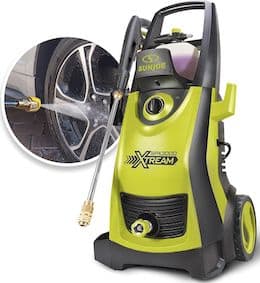
Curated with aloha by
Ted Mooney, P.E. RET

The authoritative public forum
for Metal Finishing 1989-2025

-----
Remove lime scale from toilet bowls, shower doors & dishwasher
Q. Is it ok to leave Lime-a-way in a pot over night?
Shannon M Wharton- Buchanan, Michigan
April 7, 2020

A. Hi Shannon. Not a good idea, per them ⇨
Regards,

Ted Mooney, P.E. RET
Striving to live Aloha
finishing.com - Pine Beach, New Jersey
⇩ Related postings, oldest first ⇩
Q. We have well water in our home and there is lime buildup in my toilet bowls, glass shower doors and my stainless steel dishwasher also has white scale in it...I have been using Lime-A-Way
⇦ this on
eBay
or
Amazon [affil links]
since the product came out, but the lime scale is just getting harder to remove especially in the toilet bowls where there are heavy rings at the water line. If I try to chip them off, I will ruin the porcelain.
Please let me whether or not I can use muriatic acid
⇦ this on
eBay or
Amazon [affil links] and also how to use it and how often to use it to remove the lime buildups... If you can suggest another product that is less harmful to use, please do so.
Thank you for helping me with this problem.
retired - Edison, New Jersey
2006
A. No, do not use muriatic acid (hydrochloric acid).
It ruins aluminum, brass, chrome, copper, galvanized, nickel, people, plumbing, stainless & non-stainless steels and tile. Even without direct contact, damage occurs from fumes. So, it was wise to inquire, as many others have asked how to fix the damage done.
Only use rust, scale, lime, and stain removers sold specifically for bathroom and kitchen surfaces. Unlike commercial acids, these are low-fuming and contain inhibitors to protect (most) metal surfaces.
Read the labels before buying.
- Goleta, California
Rest in peace, Ken. Thank you for your hard work which the finishing world, and we at finishing.com, continue to benefit from.
A. I have had considerable success leaving Coca Cola in the toilet pan overnight- it is a low-tech solution, but seems to work!
Moira Dyson- Bookham, Surrey, United Kingdom
A. I have used a product called Kilrock "K", available from UK hardware stores. It is successful every time. It contains formic acid instead of hydrochloric. It doesn't seem to be available in NZ (friends tell me) but maybe there are other products that use formic acid.
Tony Vinicombe- Shoreham, West Sussex, UK
2007
Q. My bathtub walls have muriatic acid stains. I would like to know any suggestions for removal.
Thank you.
Barbara
renovator - New Orleans, Louisiana
May 18, 2008
A. I had great success using spray C-L-R ⇦ this on eBay or Amazon [affil links] and paper toweling. You put the toweling up against the shower wall and spray it till it stays stuck to wall. (I also slid my pinkie along the grout lines so the paper stuck there.) I kept the door closed and then went back about every 20 minutes to spray from the top down so it wouldn't get dry. The shower came out perfect but I did it on new tile. You should do a test spot first.
Nancy Mattia- Fairfield, New Jersey
A. I have found that a steam cleaner ⇦ this on eBay or Amazon [affil links] can do wonders. It was a last attempt after trying all the name brand cleaners and industrial cleaners I could get a hold of. It helps clean everything off. I had a bath tub we were going to replace on a whim I tried a Shark Steam Buster on it and the heavy lime scale build up came off like paint chips I was able to just sweep out the tub and it was extremely less expensive than replacing the tub.
Jay Marx- Washington, Utah
Q. My house is going on 7 years old,I have lived in it for 3 yrs. One commode has lime deposits ring at the water line. I haven't found anyway to remove it yet. I have tried scouring pads with Bon Ami with no results. Also, I have a septic tank sewage disposal system. WHAT CAN I USE TO REMOVE THIS RING OF SCALE? Thanks
Peter Anderson- Purvis, Mississippi USA
November 16, 2009
A. Buying deck cleaning crystals (oxalic acid) and adding a few tablespoons will remove both lime and rust type heavy scale if left overnight from toilets, baths, etc. Remove as much water as possible and then pour a jug of boiling water into toilet. Add a few tablespoons of oxalic acid and stir. Leave overnight. Very heavy scale will need to have a few scrapes with a screwdriver to chip out some areas to allow the acid to get a foothold.
cam parsonson- christchurch, new zealand.
December 29, 2010
A. I don't usually do these forums but I read above about hydrochloric acid (I'd tried everything else), so I went out to our cupboard and got our pool acid (it's a teeny tiny Clarke Rubber pool but we have to use the pool acid every now and then) and poured a bit into the bowl, stepped back, came back about 20 seconds later and brushed, OMG, amazing! New toilet. So I would recommend going to a local pool shop and just keeping a small bottle of pool acid somewhere safe. Get some gloves and even stick a toothbrush into it for the rim of the loo. I am amazed! So that idea about acid above wasn't such a bad one, thank you!
Jennifer Simmonds- Victoria Australia
June 3, 2011
A. I had three toilets that had heavy build-up of lime in the bowls, I had tried everything C-L-R, Lime Away and even pumice stone to no great difference. I just tried Muriatic Acid ⇦ this on eBay or Amazon [affil links] and WOW it worked great, the toilets looked new. You get a couple of gallons of stuff for only $10.00, so it will last me some time. Just make sure you cover the floor and wear gloves and face protector and glasses. Works Wonders!
Bob Atkinson- San Jose California USA
Hi Jennifer; hi Bob. It may have worked, but it's still not a good answer. As Ken Vlatch implied earlier, muriatic acid (HCl) is not really a liquid like many other acids are ... it's a gas dissolved in water. That means the chrome and stainless in your bathroom, and any wiring or other corrodables are at risk -- it doesn't take a splash to ruin them, they can be ruined by the fumes. Please see if the hardware store has a muriatic acid "substitute". Good luck.
Regards,

Ted Mooney, P.E.
Striving to live Aloha
finishing.com - Pine Beach, New Jersey
A. Muriatic acid is definitely sold in liquid form, and it is safe to use in your toilets, bathtubs, dishwasher. Anywhere that water is used, including drain pipes that are PVC, rubber, etc. I'll say that again, ANYWHERE water is used. Use a 5% solution and you're good to go. Follow all instructions and safety precautions. But Ken is wrong as are you. I use the stuff regularly, on major home appliances pools, tools, sheet metal, concrete and many others.
John The Appliance Guy- Las Vegas, Nevada
February 9, 2023
Tip: This forum was established to build camaraderie among enthusiasts through sharing of tips, opinions, pics & personalities.
The curator & some of the readers who publicly share their info are unlikely to engage with posters who don't.
A. Thanks John. The more that muriatic acid is diluted, the less harmful it is to metal, and 5% is quite dilute -- but it's still bad for metal. For one example, see the many horror stories on topic 17903, "Muriatic acid corroded our stainless steel appliances".
Luck & Regards,

Ted Mooney, P.E. RET
Striving to live Aloha
finishing.com - Pine Beach, New Jersey
A. To remove lime scale, here is a good trick. Make a paste of baking soda, white vinegar ⇦in bulk on eBay or Amazon [affil links] and peroxide. Apply directly to the lime scale and let set for at least 2 hours. Then brush away the scale. THIS WORKS! I had a terrible problem with lime scale in my toilet bowl and it took two applications but it is gone now. Good luck!
Adrienne Rollo- New Vineyard, Maine, USA
November 11, 2011
A. I have just had a lady come in and restore our showers and she sold me a product called "Heavy Duty Restorex". My toilets were terrible, they have come up like new again. buyrestorex.com
Jackie Rogers- New Zealand
February 22, 2012
Q. Our toilet has an opening, opposite to the discharge opening (i.e.: opposite to the "sewer" opening). Its purpose seems to be to provide an extra flow of water to help push solid waste out from the toilet and into the outlet to the sewer. I attached a photo, showing my finger pointing at the opening.

My problem is that, just inside the opening (which is about the size for a man's thumb to fit inside), it seems to be largely clogged with a very hard calcium deposit of some kind. Because of the clog, it's hard to get the toilet to flush completely. (i.e.: There are frequently nasty "floaters" bobbing around after I've tried to flush it.) It's often necessary to flush repeatedly to do the job.
I've tried scraping or chipping the calcium out, but it's very difficult to get any kind of tool in the hole with enough force to clear it.
Will appreciate recommendations.
- Arlington, Texas, USA
October 15, 2012
A. Try turning off the water, empty the bowl. Pour a pot of boiling hot water in. Now mix 1/4 cup of bleach ⇦ bleach/sodium hypochlorite in bulk on eBay or Amazon [affil links] with 2 tablespoons of POWER dish washing detergent. Add that to the water in bowl and let it soak for about an hour and it should be like brand new.
Christie Sherburne- Oakhurst, California, United States
November 12, 2012
A. Thanks Christie!
There are a thousand brands of dishwashing detergent around the world and that particular one has limited availability. Is there any generic info you can tell us about that one?
Regards,

Ted Mooney, P.E.
Striving to live Aloha
finishing.com - Pine Beach, New Jersey
A. Do it the simple way: leave normal household vinegar in the toilet bowl for about half an hour - and brush out - super! Just repeat if not enough.
Wenche Hoest- Norway
A. Just wanted to clarify the above comments about muriatic acid vs hydrochloric acid. Actually, the chemical formula for muriatic acid is HCl. But wait, isn't that the chemical formula for hydrochloric acid? You guessed it! They're the same thing. Muriatic acid is HCl. Muriatic is an antiquated term that continues to be used in some areas, like plumbing. FYI
Dave Roberts- San Angelo, Texas, US
!! There is a response concerning Hydrochloric Acid and Muriatic Acid saying Muriatic is an antiquated term because they both have the same chemical designation (HCl)...
Yes, Muriatic Acid is MADE from Hydrochloric Acid, so it would have the same chemical signature. But Muriatic is usually a 10% solution of Hydrochloric, so theoretically safer to use because it isn't as strong. I can tell you from experience, if you DO use either of these and have a septic system, you had BETTER follow your acid bath to your septic system with an alkali to neutralize it once you are done....and then reintroduce bacteria into your septic, because you have just killed it with the acid. You will have septic troubles soon if you don't. Pour old sour milk down the toilet, yeast packets are good too... just an FYI in case you didn't think about it ... like we didn't.
- South Bend Indiana, USA
May 20, 2017
 I noticed two of the suggestions included pouring boiling water into the toilet. Probably not a good idea, as there is generally a wax ring to make the seal and the heat can soften and loosen the wax. Especially bad if there is a clog.
I noticed two of the suggestions included pouring boiling water into the toilet. Probably not a good idea, as there is generally a wax ring to make the seal and the heat can soften and loosen the wax. Especially bad if there is a clog.
January 24, 2015
- Sandy, Utah, USA
![]() I have tried every store-bought lime and calcium cleanser for my toilet, but nothing worked. Then I saw the comment above:
I have tried every store-bought lime and calcium cleanser for my toilet, but nothing worked. Then I saw the comment above:
Wenche Hoest
- Norway"
My toilet, which was so discolored with hardened deposits, is almost perfect now. One more application and it will be perfect. I did, however, forget about the vinegar, and left it in for a few hours which may have helped.
M. Merenda- San Diego, California, USA
May 18, 2015
Descaler works great in kettle but ruined 2 spoons
Q. The water in London is extremely hard. I use Kilrock-K descaler (Formic Acid) in my stainless steel kettle and it possibly gleams when it's done - a mirror finish. I have 2 teaspoons marked 'Stainless Steel' which had brown limescale rings where water has sat in the bowls. One had a high gloss mirror finish, the other is cheaper and marked Foreign and was slightly duller. I dropped them in the kettle when I was descaling it -- and they both came out very dark grey with a matte finish! I had assumed, obviously wrongly, that all stainless steel is the same. I'm interested in the chemistry here -- why formic acid has had such a vastly different effect on 'different' stainless steels. What is the grey finish on my spoons? Have I taken the surface off, or have I added a layer some new oxide or similar? And can I restore their polished finish? Thanks.
Paul Doherty- London, UK
August 24, 2015
A. Hi Paul. Yes, there are many grades of stainless steel; type 316 is the most corrosion resistant of the common consumer grades. You can't fix the etching chemically, but a small buffing pad in an electric drill, and any mild polishing compound should restore the shine.
Luck & Regards,

Ted Mooney, P.E. RET
Striving to live Aloha
finishing.com - Pine Beach, New Jersey
A. I clean a building as a side job. There is terrible lime scale build up in all toilets and sinks in the restrooms. I found a product in Walmart stores called Lime Out. It worked great in the toilets. It has to set overnight without any usage of the toilet. It works.
Betty DonaldsonB & G's Cleaning Service - Gautier, Mississippi USA
September 1, 2015
A. Some wc cleaning processes suggest removing most water from the pan. Do this using a large polythene bag (bin liner); pull the bag sharply downward to inflate it; hold it tightly over the wc rim and deflate the bag sharply forcing the air into the wc pan; this will push most of the water round the bend into the waste pipe and away.
Kevin Webb- Reading, Berks, UK
A. I have the easy, cheap solution! A few years ago I searched the internet without success, for a solution to the calcium build-up in my old toilet. I got the usual answers, i.e. vinegar, various cleaning products I'd already tried, replacing the toilet, and of course the scary 'hydrochloric acid' solution. I'm on a well, and the calcium build-up in my toilets is like rough cement, which eventually begins to 'catch' the toilet paper during the flush, and, well, makes for a less than adequate flush. The deposits also tend to constrict the exit, up under the 'S' or trap, so this was more than just a cosmetic problem. I eventually settled on a routine of gently chipping the deposits off with various tools, like screwdrivers and small scrapers, using a plumber's mirror to see the area before the trap, and finishing up with pumice sticks ⇨
It took an hour for one toilet, usually, and wasn't fun. Then I had a brainstorm. I pushed as much of the toilet bowl water up and over the trap as possible, with the toilet brush, poured about 2 or 3 cups of
CLR ⇨
into the bowl, and laid paper towels over the entire rim, and let it wick up the CLR from the bottom to the rim area. I shut the lid and let it sit overnight. TA DA! Amazing results!
- Ramona, California USA
July 25, 2016
A. I just want to mention a cleaner for toilet bowls called "ZEP" Toilet Bowl Cleaner ⇨
It costs about $10.00 for a gallon. Empty out most of the water and let it soak in toilet bowl to remove calcium, mineral deposits, etc.
- Rochester, New York US
A. The ONLY thing that worked for me in getting calcium deposits out of the toilet bowl was to literally chip them off with a screwdriver. Pumice stones don't work, the deposits are too hard and you will spend hours and hours trying and still have much left over...which then just accumulates more.
Don't chip away at the calcium so hard that you chip the porcelain, but you may notice some black marks from the screwdriver on the calcium when you finish. Don't worry about it. Surprisingly, they wash away in a week or so.
- Los Angeles California, USA
March 30, 2017
A. Hello
I use 5 -10 "Steradent" denture cleaning tablets ⇨
throw them in, scrub around and leave as long as possible, all day or overnight. Repeat until all stains have been removed. You may need to do this a few times but it's a lot nicer than those nasty acids. :)
- Adelaide SA Australia
April 17, 2017
A. I had a really bad build of of calcium - tried everything under the sun but nothing worked.
That is until my son brought the power washer ⇨
upstairs! We connected it to a sink tap and he blasted away - the calcium came clean out in large pieces leaving the bowl like new. (I removed the water first and he wore goggles as a precaution). Great fun and weirdly satisfying.
- Glanmire, Cork Ireland
A. I have found a product called Acid Magic that is rather expensive US $20 but it works very well. Buy it at a local hardware store. Do not know how it would interact with a septic system but no problems and I have used this product for almost 15 years.
R K Nolan- Indiana USA
A. I have had to work around hard water for decades, then I found the answer: use a whole-house filter, such as a hydrogen peroxide injector system and then polish it off with a tiny bit of water softener system. You've got to think about your house and its plumbing, as well as your personal health. Treat the water problem first, and you'll have no further problems.
Billy Bob Smythe- South Hampton, Colorado, USA
May 17, 2018
Q. My name is Lisa. My question is: Can I use Lime-a-way Toggle in the toilet bowl?
Lisa McDonald- Phoenix Arizona USA
March 27, 2019
Q, A, or Comment on THIS thread -or- Start a NEW Thread



